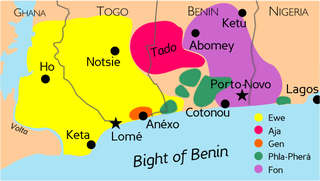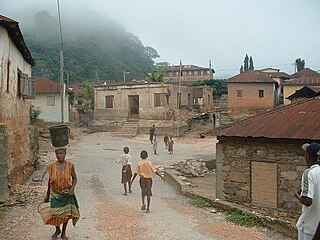Related Research Articles

The Kwa languages, often specified as New Kwa, are a proposed but as-yet-undemonstrated family of languages spoken in the south-eastern part of Ivory Coast, across southern Ghana, and in central Togo. The name was introduced 1895 by Gottlob Krause and derives from the word for 'people' (Kwa) in many of these languages, as illustrated by Akan names.

Ewe is a language spoken in Togo and southeastern Ghana by approximately 6.61 million people as a first language and a million or so more as a second language. Ewe is part of a cluster of related languages commonly called Gbe; the other major Gbe language is Fon of Benin. Like many African languages, Ewe is tonal.
Gen is a Gbe language spoken in the southeast of Togo in the Maritime Region. Like the other Gbe languages, Gen is a tonal language.

Fon is spoken mainly in Benin by approximately 1.7 million speakers, by the Fon people. Like the other Gbe languages, Fon is an isolating language with an SVO basic word order.

The Gbe languages form a cluster of about twenty related languages stretching across the area between eastern Ghana and western Nigeria. The total number of speakers of Gbe languages is between four and eight million. The most widely spoken Gbe language is Ewe, followed by Fon. The Gbe languages were traditionally placed in the Kwa branch of the Niger–Congo languages, but more recently have been classified as Volta–Niger languages. They include five major dialect clusters: Ewe, Fon, Aja, Gen (Mina), and Phla–Pherá.

The Anlo Ewe are a sub-group of the Ewe people of approximately 6 million people, inhabiting southern Togo, southern Benin, southwest Nigeria, and south-eastern parts of the Volta Region of Ghana; meanwhile, a majority of Ewe are located in the entire southern half of Togo and southwest Benin. They are a patrilineal society governed by a hierarchal, centralized authority. Their language is a dialect of the Ewe language, itself part of the Gbe language cluster. The Ewe religion is centered on a supreme god Mawu and several intermediate divinities. Christianity has now been accepted in every part of Anlo Ewe land and with minority of the people still believing vodun beliefs. The vodun also known as part of the traditional religion is now becoming a previous religion. The youth of the community today accepting Christianity much more. However, those who still believe in the vodoo worship also believes their tradition is a factor that keeps integrity and probity while Christianity stands to pave way for integrity, honesty and probity to be washed away as years go by and it is for this reason they always do away with this Christianity when it comes to issues of accountability.
The Phla–Pherá (Xwla–Xwela) languages form a possible group of Gbe languages spoken mainly in southeastern and southwestern Benin; some communities are found in southeastern Togo and southwestern Nigeria. The group, comprising about ten varieties, was introduced by H.B. Capo in his 1988 classification of Gbe languages as one of the five main branches of Gbe. Additional research carried out by SIL International in the nineties corroborated many of Capo's findings and led to adjustment of some of his more tentative groupings; in particular, Phla–Pherá was divided in an eastern and a western cluster. Phla–Pherá is one of the smaller Gbe branches in terms of number of speakers. It is also the most linguistically diverse branch of Gbe, due partly to the existence of several geographically separated communities, but mainly because of considerable influence by several non-Gbe languages in the past. Some of the Phla–Pherá peoples are thought to be the original inhabitants of the region having intermingled with Gbe immigrants.
The Ewe people are a Gbe ethnic group. The largest population of Ewe people is in Ghana, and the second largest population in Togo. They speak the Ewe language which belongs to the Gbe family of languages. They are related to other speakers of Gbe languages such as the Fon, Gen, Phla Phera, and the Aja people of Togo and Benin.
In Ewe oral history, Amedzofe, literally 'origin/home of humanity', is one of the names for Ketu. Ketu, in present-day Benin, was a central place in the history of the Gbe peoples. The Gbe peoples originally were part of the Yoruba Oyo people of Nigeria, but they were pressed westward by a series of wars between the 10th and the 13th century. In Ketu, the ancestors of the Gbe-speaking peoples separated themselves from other refugees and began to establish their own identity.
Ketu is a historical region in what is now the Republic of Benin, in the area of the town of Kétou (Ketu). It is one of the oldest capitals of the Yoruba-speaking people, tracing its establishment to a settlement founded by a descendant of Oduduwa, also known as Odudua, Oòdua and Eleduwa. The regents of the town were traditionally styled "Alaketu", and are related directly to Ile-ife in present-day Nigeria.

Ghana is a multilingual country in which about eighty languages are spoken. Of these, English, which was inherited from the colonial era, is the official language and lingua franca. Of the languages indigenous to Ghana, Akan is the most widely spoken.
The Lambas are an ethnic and linguistic group of people living in the Kéran and Doufelgou Districts (Préfecture) of the Kara Region in Northern Togo and in the Atakora and Donga Departments of Bénin, West Africa. The capital of the Kéran District is Kanté and the capital of the Doufelgou District is Niamtougou.

The Logba people live in the Volta Region of Ghana, east of the Volta Lake in the mountains of the Ghana-Togo borderland. Most Logba towns and villages are situated along the trunk road from Accra to Hohoe. They include the following settlements: Wuinta, Akusame, Adiveme, Andokɔfe, Adzakoe, Alakpeti, Klikpo, and Tota. Tota is located high in the Ghana Togo Mountains to the east of the Accra-Hohoe road. Alakpeti is the commercial centre of Logba, while Klikpo is traditionally the seat of the head of the Logba people. The Logba people are primarily subsistence farmers, producing cassava, maize, yams and forest fruits, supplemented by cash crops like cocoa, coffee and sawn mahogany logs. The Logba area is known for its scenery, which includes waterfalls, cliffs, and limestone formations, including one or two known small caves with minor speleothems.

The Aja language is a Gbe language spoken by the Aja people; and it is closely related to other Gbe languages such as Ewe, Mina, Fon, and Phla Phera.
Gun language is a language in the Gbe languages group. It is spoken by the Ogu people in Benin Republic and Nigeria. The language is close to Fon, as well as to Agbome, Kpase, Maxi and Weme (Ouémé) languages. It is the second most spoken language of Benin. It is used in some schools in the Ouémé Department of Benin.

The Volta–Niger are a proposed but undemonstrated family of languages, also known as West Benue–Congo or East Kwa. Among these are the most spoken languages of southern Nigeria, Benin, Togo, and southeast Ghana: Yoruba, Igbo, Bini, Fon, and Ewe.
Alada (Arba) is a Gbe language of Nigeria and Benin that has proven difficult to classify. Ethnologue counts it and Tɔli as dialects of Gun, but Capo (1988) considers it one of the Phla–Pherá languages. Kluge (2000) found elements of both Fon–Gun and Phla–Pherá.
Tɔli (Toli) is a Gbe language of Benin. Ethnologue counts it and Alada as dialects of Gun, but Capo (1988) considers it one of the Phla–Pherá languages.
Hounkpati B Christophe Capo is a Beninese linguist, and professor of linguistics at the Université d'Abomey-Calavi in the Republic of Benin.
References
- ↑ Waci at Ethnologue (18th ed., 2015)
- Capo, Hounkpati B.C. (1988) Renaissance du Gbe (réflexions critiques et constructives sur L’EVE, le FON, le GEN, l AJA, le GUN, etc.) . Hamburg: Helmut Buske Verlag.